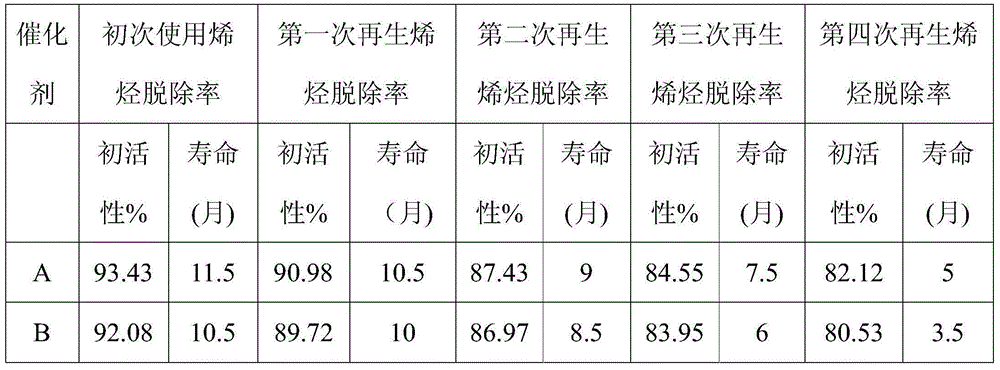A kind of modified clay catalyst for deolefin and preparation method thereof
A technology for de-olefins and catalysts, which is applied in the field of catalysts for trace olefins, can solve the problems of poor regeneration performance and expensive catalysts for de-olefins, and achieve the effects of reducing acid strength, reducing coking and carbon deposition, and overcoming easy deactivation
- Summary
- Abstract
- Description
- Claims
- Application Information
AI Technical Summary
Problems solved by technology
Method used
Image
Examples
Embodiment 1
[0031] Take 14.5g of pretreated attapulgite clay, add 39ml of lanthanum nitrate solution containing 0.5% (mass fraction) of lanthanum, stir and ultrasonically 1h; then add 1g of phosphotungstic acid roasted at 180°C to the slurry, and continue stirring for 1h , then soaked for 14h and dried. The modified attapulgite clay loaded with two active components was obtained.
[0032] Take 6.4g of pseudo-boehmite and 40ml of water into a beaker, and stir to form a solution. Get all the modified attapulgite clay prepared above into the beaker. Stir under heating until the solution is evaporated to dryness, and the heating temperature is 70°C.
[0033] After drying, add 0.2g of scallop powder to the dried powder, add dilute nitric acid dropwise to adjust to the degree suitable for extruding, extrude on a screw extruder, then dry, and finally roast at 450°C for 2.5h . Denoted as catalyst A.
[0034] from figure 1 It can be seen that the structure of catalyst A is as follows: rare e...
Embodiment 2
[0036]Take 16g of pretreated attapulgite clay, add 40ml of neodymium nitrate solution containing 1% (mass fraction) of neodymium, stir and ultrasonically 1.2h; then add 1.2g of phosphotungstic acid roasted at 200°C to the slurry, and continue stirring 1.5h, then soaked for 12h, and dried. The modified attapulgite clay loaded with two active components was obtained.
[0037] Take 7.8g of aluminum sol and 24ml of water into a beaker, and stir to form a solution. Get all the modified attapulgite clay prepared above into the beaker. Stir under heating conditions until the solution is evaporated to dryness, and the heating temperature is 60°C.
[0038] After drying, add 0.1g of squat powder to the dried powder, add dilute nitric acid dropwise to adjust to the extent suitable for extruding, extrude on a screw extruder, then dry, and finally roast at 350°C for 3h. Denoted as Catalyst B.
Embodiment 3
[0040] Take 12g of pretreated attapulgite clay, add 34ml of cerium ammonium nitrate solution containing 0.3% (mass fraction) of cerium, stir and ultrasonically 1.5h; then add 2g of molybdosilicic acid roasted at 150°C to the slurry, and continue stirring 2h, then soaked for 14h, and dried. The modified attapulgite clay loaded with two active components was obtained.
[0041] Take 8.1g of diaspore and 45ml of water into a beaker, and stir to form a solution. Get all the modified attapulgite clay prepared above into the beaker. Stir under heating until the solution is evaporated to dryness, and the heating temperature is 50°C.
[0042] After drying, add 0.2g squat powder to the dried powder, add dilute nitric acid dropwise to adjust to the extent suitable for extruding, extrude on a screw extruder, then dry, and finally roast at 250°C for 4h. Denoted as catalyst C.
PUM
| Property | Measurement | Unit |
|---|---|---|
| quality score | aaaaa | aaaaa |
Abstract
Description
Claims
Application Information
 Login to view more
Login to view more - R&D Engineer
- R&D Manager
- IP Professional
- Industry Leading Data Capabilities
- Powerful AI technology
- Patent DNA Extraction
Browse by: Latest US Patents, China's latest patents, Technical Efficacy Thesaurus, Application Domain, Technology Topic.
© 2024 PatSnap. All rights reserved.Legal|Privacy policy|Modern Slavery Act Transparency Statement|Sitemap



